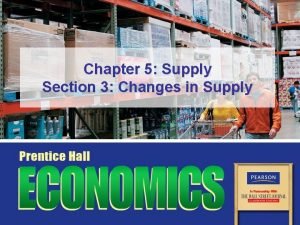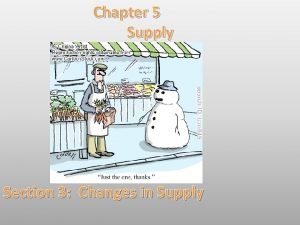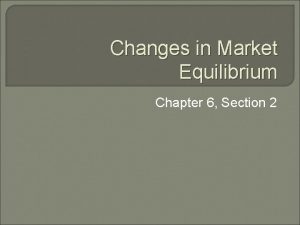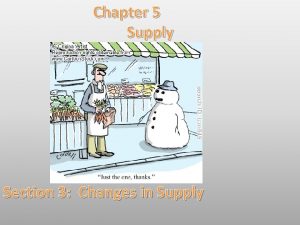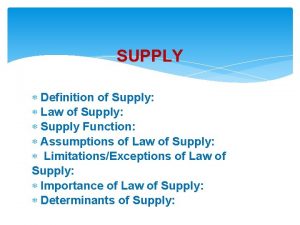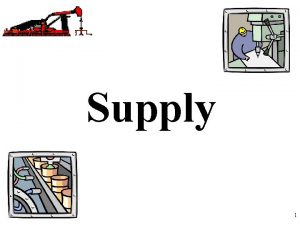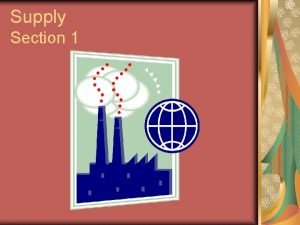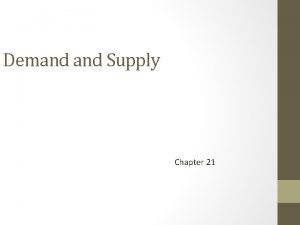Chapter 5 Supply Section 3 Changes in Supply








- Slides: 8

Chapter 5 Supply Section 3: Changes in Supply

Lesson Objectives: By the end of this lesson you will be able to: *Explain how factors such as input costs create changes in supply. *Identify three ways that the government can influence the supply of goods. *Analyze other factors that affect supply. *Explain how firms choose a location to produce goods.

Input Costs An input is something that is used to produce a good (a tool, a machine, labor, supplies). Any change in the cost of an input used to produce a good (i. e. materials, machinery, labor) will affect supply. A rise in the cost of an input will cause a fall in supply at all price levels because the goods has become more expansive to produce. A fall in the cost of an input will cause an increase in supply at all price levels.

Effect of Rising Costs A supplier sets output at the most profitable level. If the cost of materials increase, it may cost more to make the product than it costs to purchase it. Technology Input costs can drop as well. Advances in technology can lower production costs in may industrials. Computers and e-mail are two examples of money saving technology.

Government’s Influence on Supply The government has the power to affect the supplies of many types of goods. By raising or lowering the cost of producing goods, the government can encourage or discourage an entrepreneur or an industry. Subsidies One method used by governments to affect supply is to give subsides to the producers of a good (usually food). A subsidy is a government payment that supports a business or market. The government often pays a producer a set subsidy for each unit of a good produced. Subsidies generally lower costs, allowing a firm to produce more goods.

Taxes A government can reduce the supply of some goods by placing an excise tax on them. An excise tax is a tax on the production or sale of a good. Excise taxes are sometimes used to discourage the sale of goods that the government thinks are harmful to the public (cigarettes & alcohol). Regulation Laws or rules made by the government that may cause an increase or decrease in supply. Example of regulation: In 1970, the federal government required car manufactures to install technology to reduce pollution from auto exhaust. This law increased the cost of manufacturing cars and reduced the supply.

Other Influences on Supply *Changes in global economy. *Future Expectations of Prices *Expectations of higher prices will reduce supply now and increase supply later. *Expectations of lower prices will have the opposite effect (increase supply now and reduce supply later). *Number of Suppliers *The more suppliers you have, the more goods produced. *The less suppliers you have, the less goods produced.

Where Do Firms Produce? Cost of Transportation is a key factor. Firms tend to locate close to input suppliers when inputs (materials) are expensive to transport. Example: A firm produces tomato sauce. It takes five tons of tomatoes to make one ton of tomato sauce. The firm locates close to tomato farm because it is cheaper to ship one ton of sauce to the customers than it is to ship four tons of tomatoes to the factory. Firms tend to locate close to its consumers when output is more costly to transport. Example: A firm that bottles soft drinks does not use natural resources (soft drinks are concentrated syrup & water). The bottled drinks weigh a lot and are expensive to transport to the stores. Therefore, the firm locates itself closer to customers.
 Chapter 5 section 3 changes in supply
Chapter 5 section 3 changes in supply Chapter 5 section 3 changes in supply
Chapter 5 section 3 changes in supply Chapter 5 section 1 supply and the law of supply
Chapter 5 section 1 supply and the law of supply Changes in latitudes, changes in attitudes meaning
Changes in latitudes, changes in attitudes meaning What is physical change and chemical change
What is physical change and chemical change Chapter 6 section 2 changes in market equilibrium
Chapter 6 section 2 changes in market equilibrium Changes in demand and supply
Changes in demand and supply Chemical reactions section 1 chemical changes
Chemical reactions section 1 chemical changes Shifters of supply
Shifters of supply
